calmlenceのものづくり / The Craftsmanship of calmlence
2025.4.21
先日は、calmlenceについて大枠を少し紹介させて頂きました。
(その時の記事はこちらよりご覧ください)
今回は、calmlenceの実際のものづくりを見る上で、欠かせない存在である”生地”について話をさせて頂きます。
現在、既に販売されているcollection 004の中から、まずは2つの生地をピックアップ致します。
・Li/Co/W/He RANDOM BORDER
・Ry/Li/Mo/Co DOBBY STRIPE & DYED
以上の2つ。
僕自身も改めて生地の構造を聞くと、どちらも存分にcalmlenceのエッセンスが注ぎ込まれていると感じました。
まずは、”RANDOM BORDER”の生地から。

複数の色合いと、規則的ではない、ものすごく複雑な糸の見え方。
そして、立体的でボコボコとした表面は、類い稀な奥行きを持つもの。
パッと見ただけでは、一体どのような構造で形づくられているのか見当がつかない生地は、熊谷氏が「他ではないだろう」と断言しているものである。
また、とても興味深い言葉も言われていました。
「”頭を動かす”という行為だけでは、生み出すことができない生地だと思う。」
「とにかく体を動かして、やっとできたもの。」と。
具体的に紹介致します。
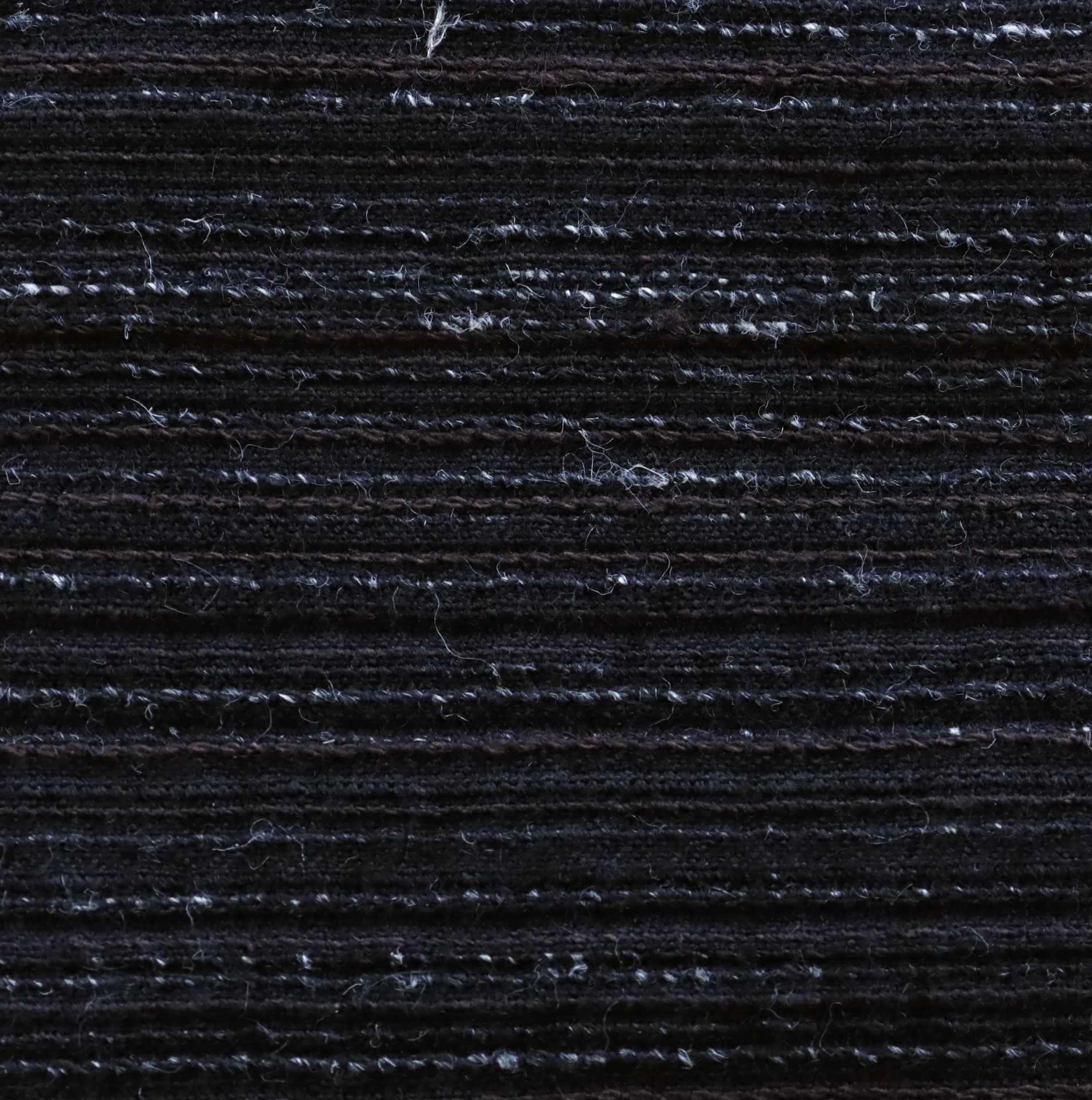
まず、この生地は、全部で4種類の糸からなるものである。
経糸は、”80番手双糸の黒い色のコットン糸”。
この経糸は、表側にはほとんど現れません。
緯糸は、3種類。
1つ目は、とても複雑。
ウール繊維とヘンプ繊維を紡績で混ぜ合わせ、一本の糸に。
その糸を繊維特性の違いからウール繊維のみを黒く染め、ヘンプを白い状態で残した24番手単糸という太い糸にする。
そこに、60番手単糸という細さで、黒く染められたリネンを撚り合わせ、”ウール(黒)・ヘンプ(白)・リネン(黒)”という白いヘンプがチラチラと見え隠れし、着物の”絣”のような表現をした糸。
この糸は、calmlenceを象徴する糸だと思っている。
次に2つ目。
40番手単糸の黒いコットン。
上記の通り、経糸は80番手双糸であるが、それと太さを合わせ、他の緯糸の素材を引き立たせるように配置されるものである。
ただ、経糸は双糸使いすることで、織り上げ強度を増しているが、緯糸では同等の太さで単糸使いしている。
最後に、3つ目。
43番手双糸という太さで、ブラウンに染色されたリネン糸である。
このRANDOM BORDERという生地の中で、とても目を惹く、太く茶色い糸である。
このような糸使いの生地を、毛織物の産地である尾州で”ジャガード織機”を用いて、織り上げている。
ジャガード織機というのは、”何でもできる”と言われるそうであるが、熊谷さんは「何でもできるからこそ、そこに感覚が問われ、差が生まれるものだと思っている」と言われていた。
そして、この生地は、冒頭に記載をした通りの言葉で自らが表現されているほどのものである。
まず、生地を一緒に開発する尾州の機屋さん。
“最先端の技術”を持つ機屋さんであると言う。
これまではションヘル織機など、その産地ならではであり、昔ながらのスーツ生地を織っている機屋さんと一緒にたくさんのものづくりを行なってきたそうです。
現在は、ジャガード織機で最先端のものを織っている機屋さんと、このようなcalmlenceのオリジナル生地を開発していることがとても興味深い。
更に、毛織物の産地ということで、尾州では通常ならば、経糸にウール糸をセッティングしているはずであるが、一緒に取り組む機屋さんは、日頃はこのジャガード織機に極細のポリエステル糸をセットして、緯糸にもポリエステルを打ち込み、服地ではない、様々なカーシートを織り上げているそうだ。
その中で、普段、生地を織った反物の最後に、calmlence用の試作として、熊谷さんと用意をした多様な糸を、いろんな視点から打ち込み、何度も何度も何度もトライをしていったそうだ。
この生地は、calmlenceの中でも特に凝っている生地ということで、冒頭に記載をした通り、デザイナー自身が「他ではないだろう」と断言されていることや、
“頭を動かすという行為だけでは、生み出すことができない生地”
“とにかく体を動かして、やっとできた”
と言われている理由である。
しかし、闇雲に糸を変えて、組織を変えて試作をしていった訳ではなく、これまでの経験から、理論的に熊谷氏の中には、”着地点”が見えていたそうだ。
そのゴールが見えた上で、そこに到達するために、ポリエステルではなく、麻などの別の素材を緯糸に打ち込むことから始め、更にいろんな想像をしながら、どんどん試していったとのこと。
デザイナー自身からの話を聞いていて、例えるならば、”70%の着地点(ゴール地点)が見えている”中で、残りの”30%は高い技術からなる好転に委ねている”ように僕は感じた。
それは、長年の経験値から導き出された上での”ゴール地点の想像”であるものだから、着手することができるもの。
その上で、もちろん、好転したものでない限りは、コレクションに出すことがない。
“見えている着地点”と、”技術に委ねる”ところと。
そして、あたかも何十年も前につくりあげられたかのように見えるcalmlenceの生地が、”最先端の織機”と”磨き抜かれた技術”を駆使しているということ。
加えて、また後日に記載していきたいと思いますが、このようなことから、calmlenceは、”双軸”という2つの軸を持ってものづくりをしていることを強く感じました。
それは、また熊谷氏もいつも意識していると言われ、実際にcalmlenceは、コレクションを重ねる毎に、”2つの軸”で生み出されています。
そういうこともあり、”双軸のものづくり”を行ない、他では全然聞いたことがないレベルで、それらを成立させていることがcalmlenceの凄みであると思います。
すごく言葉を選ばずに言うと、このことを知った時に、
「マジでスゲー」って思った。
のと、
「バイヤーの時に知りたかったわ」って思った。
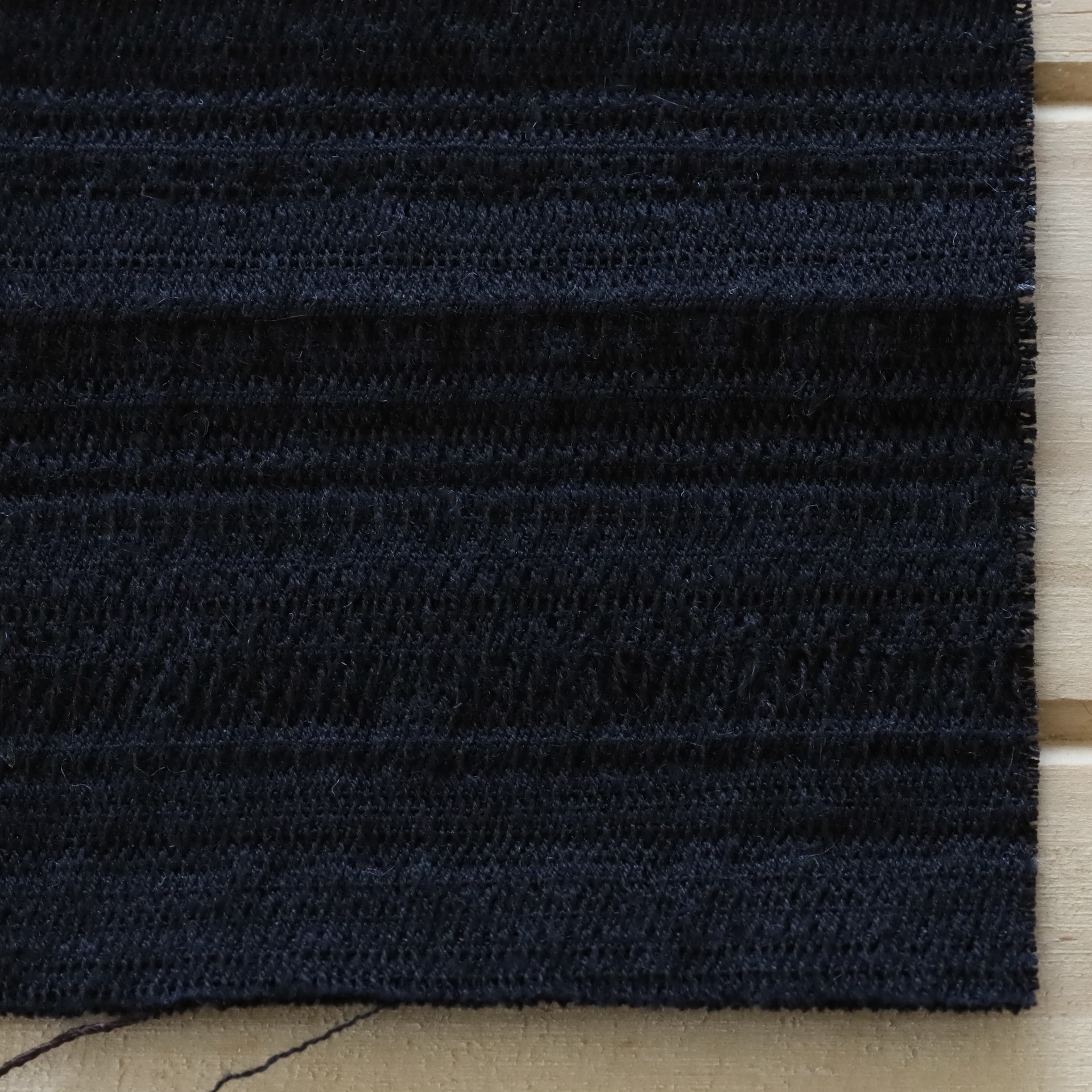
こちらは裏側の写真ですが、生地裏には、経糸のブラックのコットン糸ばかりが現れます。
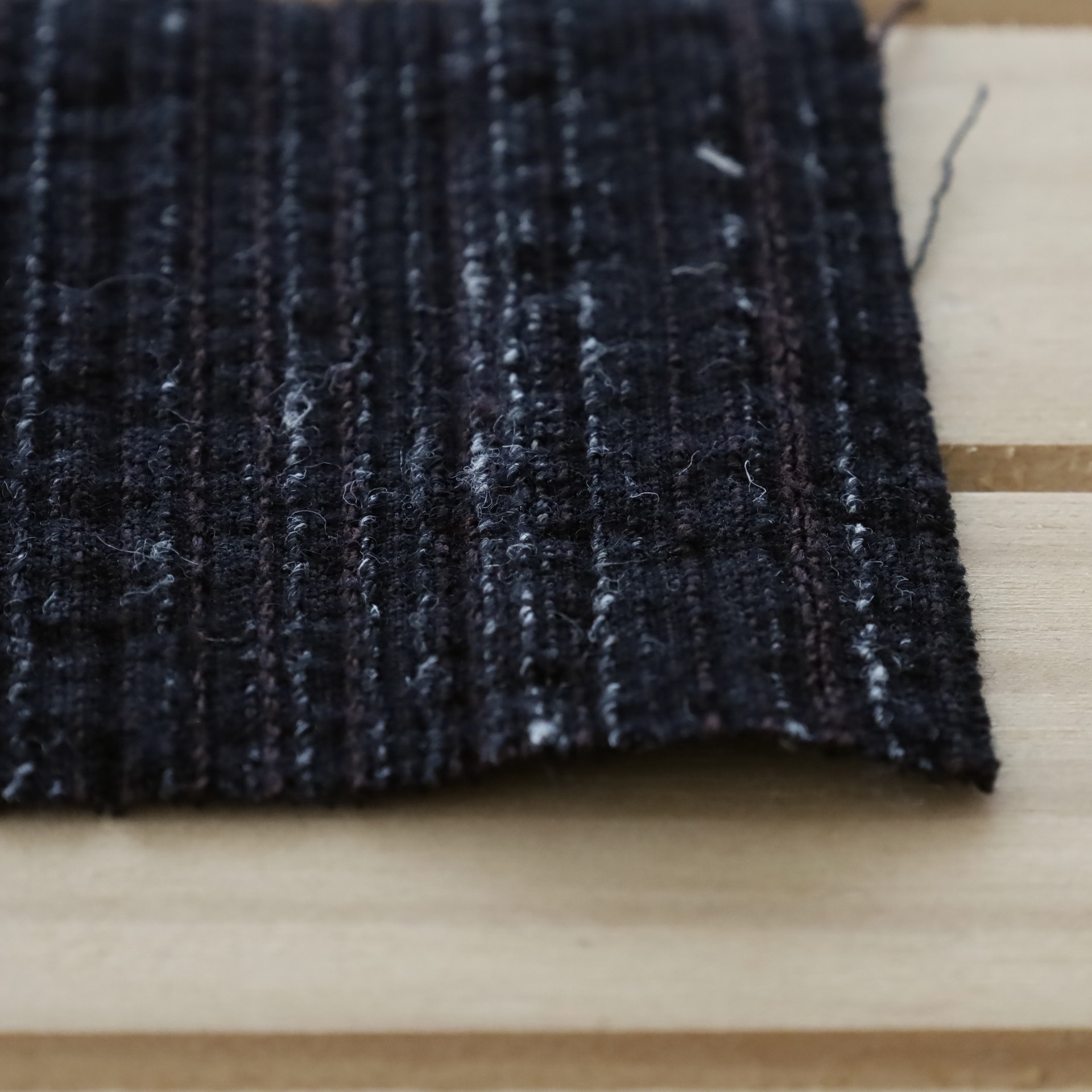
糸使いも、配列もとても複雑さを感じる緯糸。
コレクションシーズンでいうと、春夏時期ということで、ものづくりにはどうしても制約が生まれるそうです。
その中で、どこまでできるか。
絣表現をした糸をはじめ、これまでcalmlenceで使ってきた糸、つくってきた糸を入れることで、生地に非常に深みが出ているもの。
ブランドでこれまでやってきた生地づくりが複合的に凝縮されているとも言えるのが、”RANDOM BORDER”である。
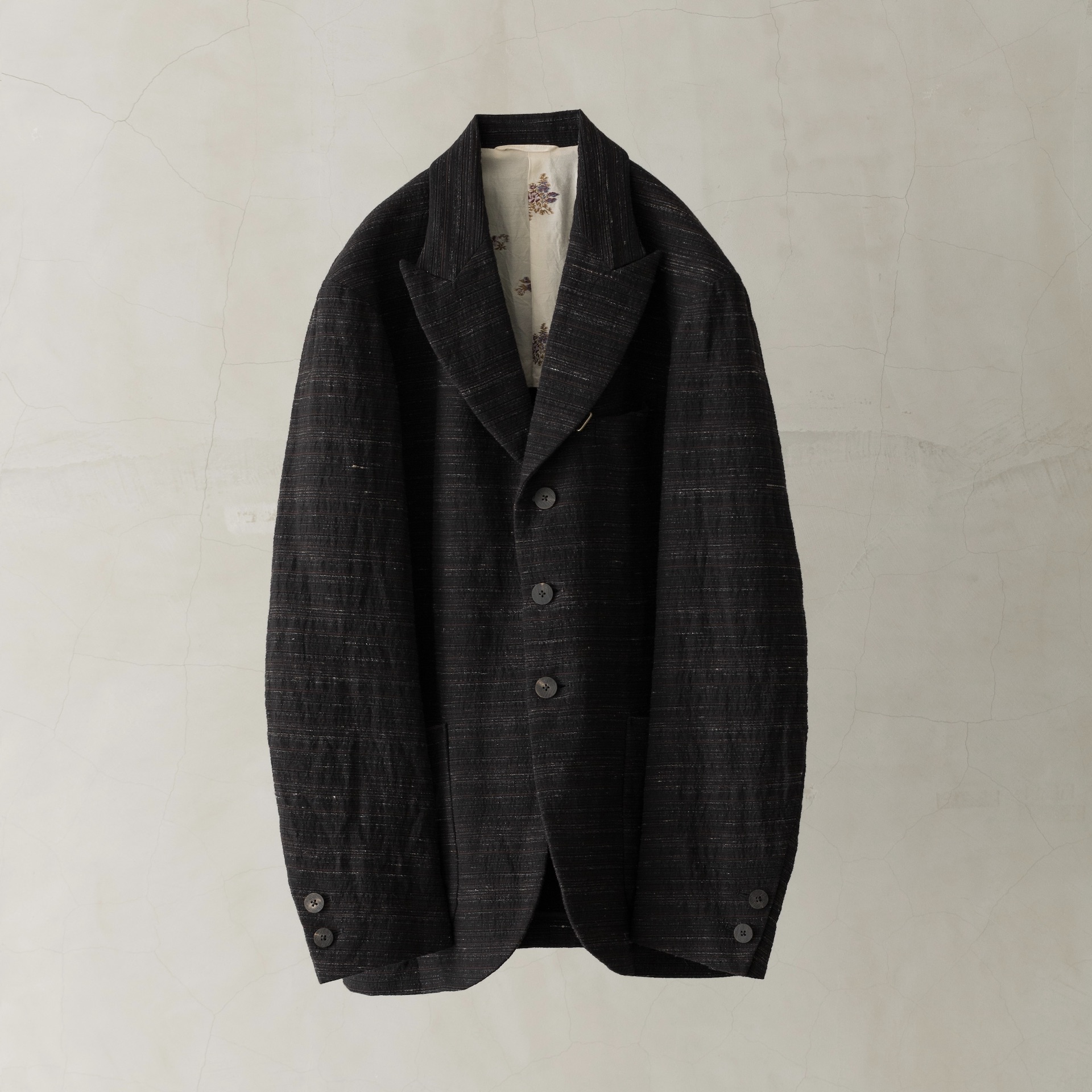
collection 004では、”PEAKED LAPEL SACK COAT”というジャケット。

ブランドを象徴する”TRIPLE PLEATED WIDE TAPERED”というスタイルのトラウザーで登場。
ピークドラペルのジャケットは、ここ最近ではあまり目にすることがないものだと思います。
その理由は、ラペル先が尖ることで、クセが出てしまい、どうしても良いレベルで服として料理することが難しく、強過ぎる洋服になってしまうからだと、僕は認識してる。
そういった面で、どんなブランドでも形にすることができない服の種類。
ただ、calmlenceではそうではなく、デザイナー自身、「梳毛のジャケットではノッチドにするけど、生地の表情が強いものはピークドラペルにしたくなる。」と。
3つボタンでボタン位置の高い、いわゆるピークドラペルのダブルのジャケットとは違う、”ピークドのワークジャケット”がすごく好きだそう。
僕自身が以前、バイヤーとしていろんなブランドを見ていた方向から考えると、生地の個性が強いものであればあるほど、一般的なノッチドラペルにして”中和”させることが多いイメージ。
例えるなら、足し算と引き算のバランスで中和させてるような。
そうではなく、生地の個性、表情が強いものを、より一層、ジャケットスタイルとして個性が際立つピークドラペルへ。
僕にとって、これは足し算どころか、掛け算のイメージ。
今までの長年の洋服づくりをやってきた経験値で、前立てがシングルのピークドラペルのジャケットが生地と相応しいと考えられているそうです。
これは、簡単にはできることではないんじゃないかと思う。
そして、パンツもスリータックの非常に特徴的なトラウザー。
上下で非常にムードが際立つ洋服スタイル。
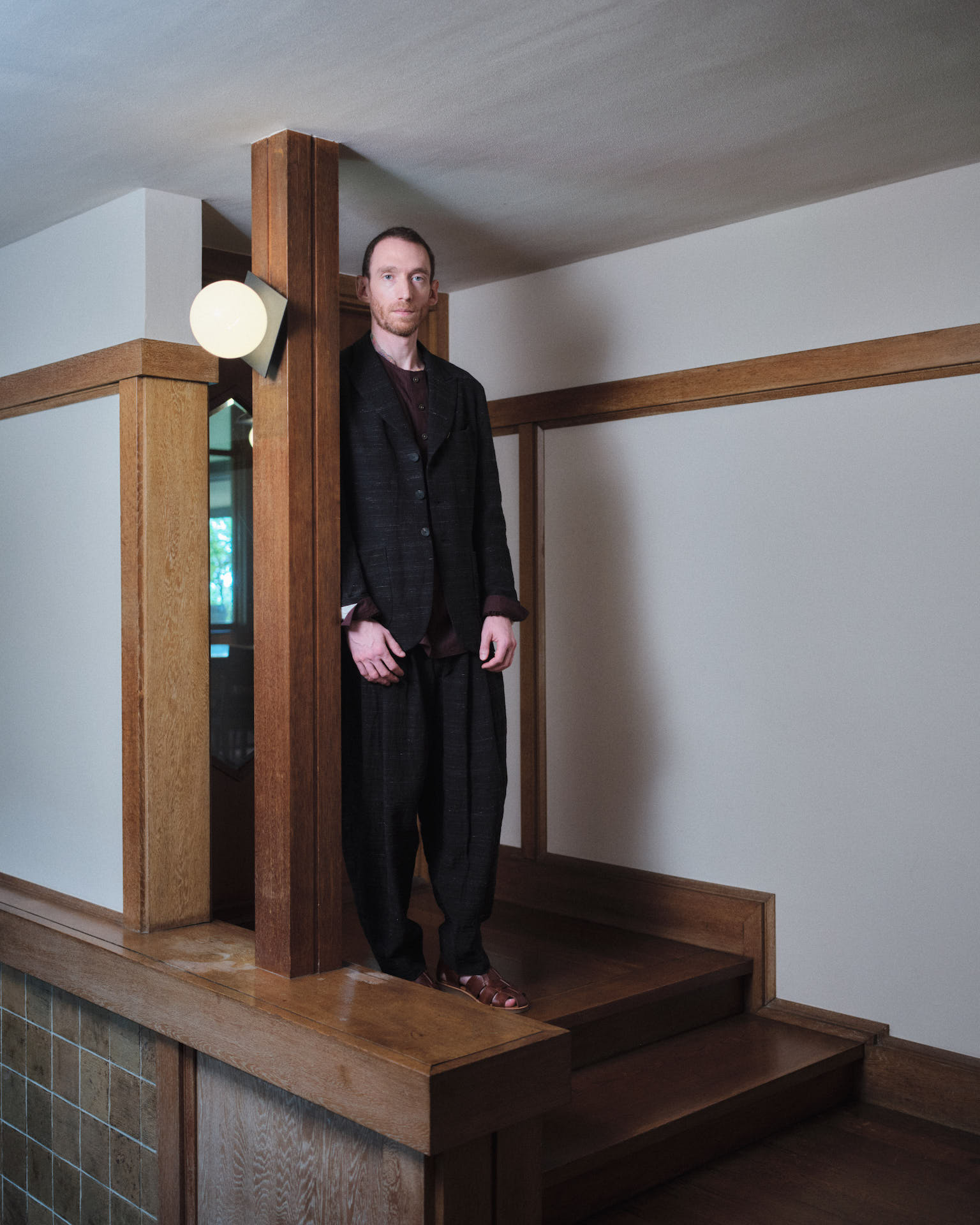

手付けのホックでスタンド着用ができるのがcalmlenceのジャケットの共通点。
ブランドのルックイメージもすごくステキ。
そして、今日、紹介するもう一つの生地。
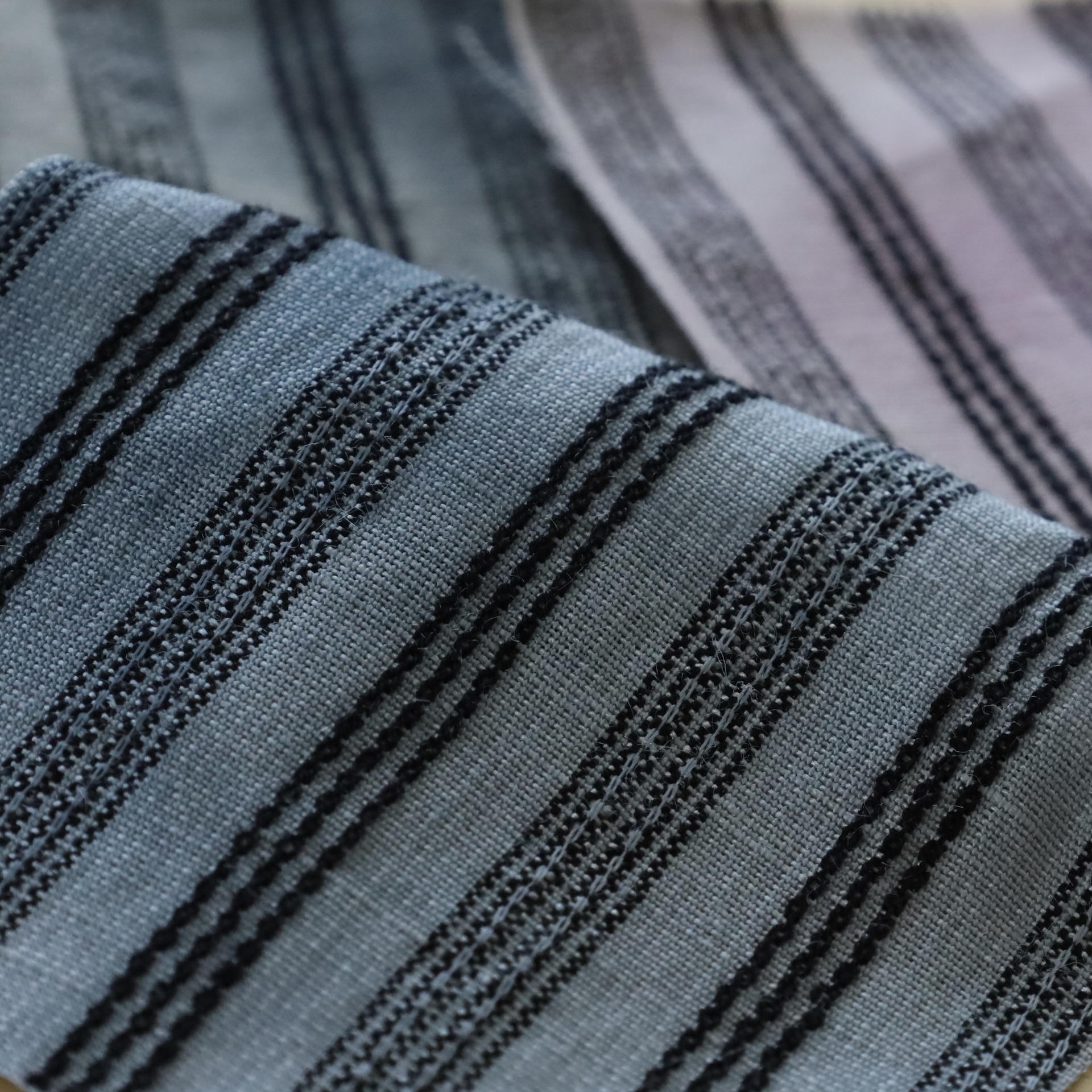
<Ry/Li/Mo/Co DOBBY STRIPE>
こちら。
2種類のレーヨン46%(一つはモダールと表記)、リネン32%、コットン22%という混率の”ドビーストライプ”と名付けられた
先ほどの生地と同じ、“ジャガード織機”で織り上げられた生地である。
通常、このような細か過ぎず、カクカクとした織り柄のストライプは、ドビー織機で織られており、それがドビーストライプと言われる。
calmlenceでも、生地の見た目が伝わりやすいようにするために、”DOBBY STRIPE”という表記としているが、実際には、この織り柄は、より細かく繊細に織り上げることができるジャガード織機じゃないと形にならないものだそうです。
この生地は、ジャガード織機で織り上げられたストライプということもあるが、多混率のマテリアル、染色、仕上げ加工など、様々に必要不可欠な工程を経て生産されています。
まず、コレクションで展開されている3色のバリエーション。
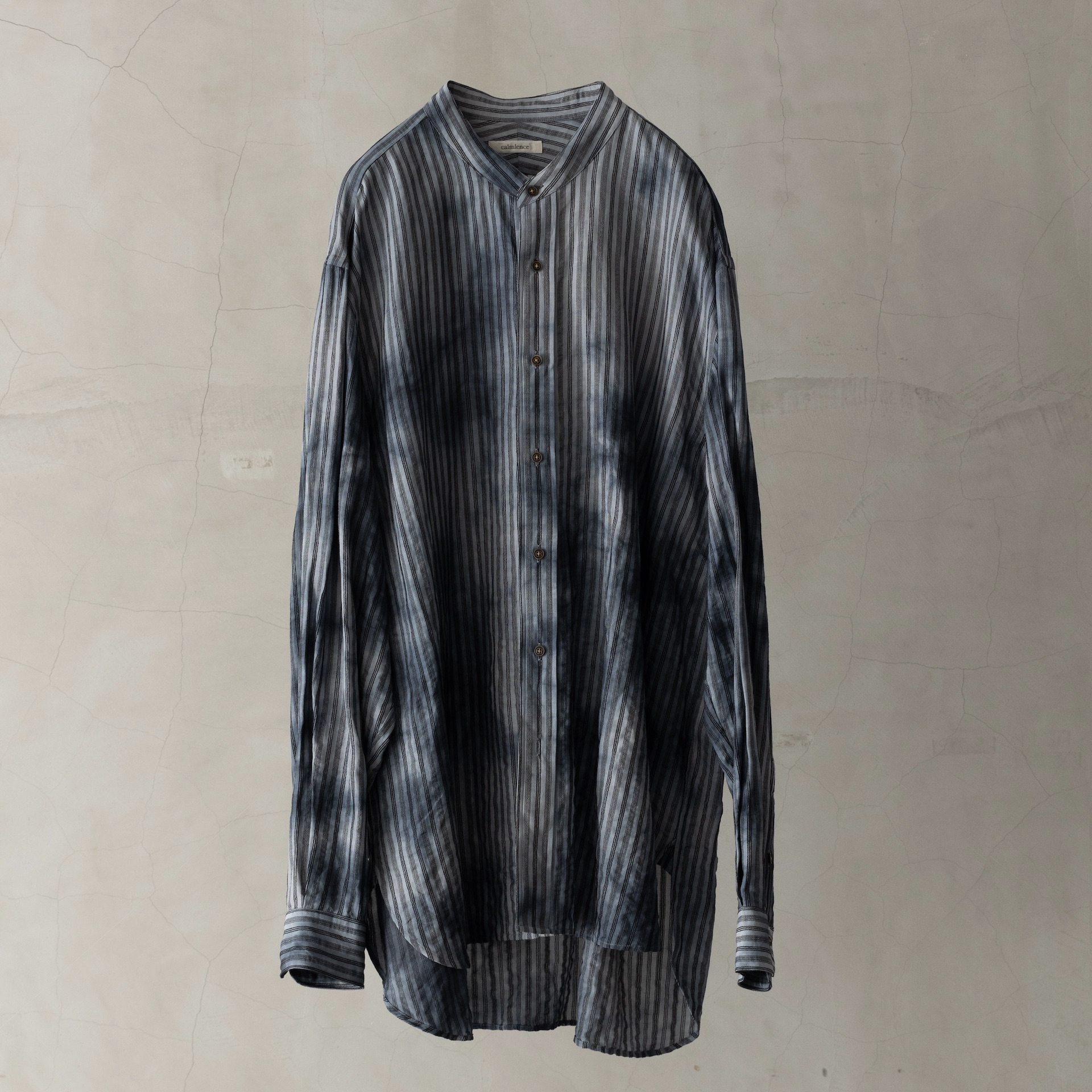
ブルーストライプ。
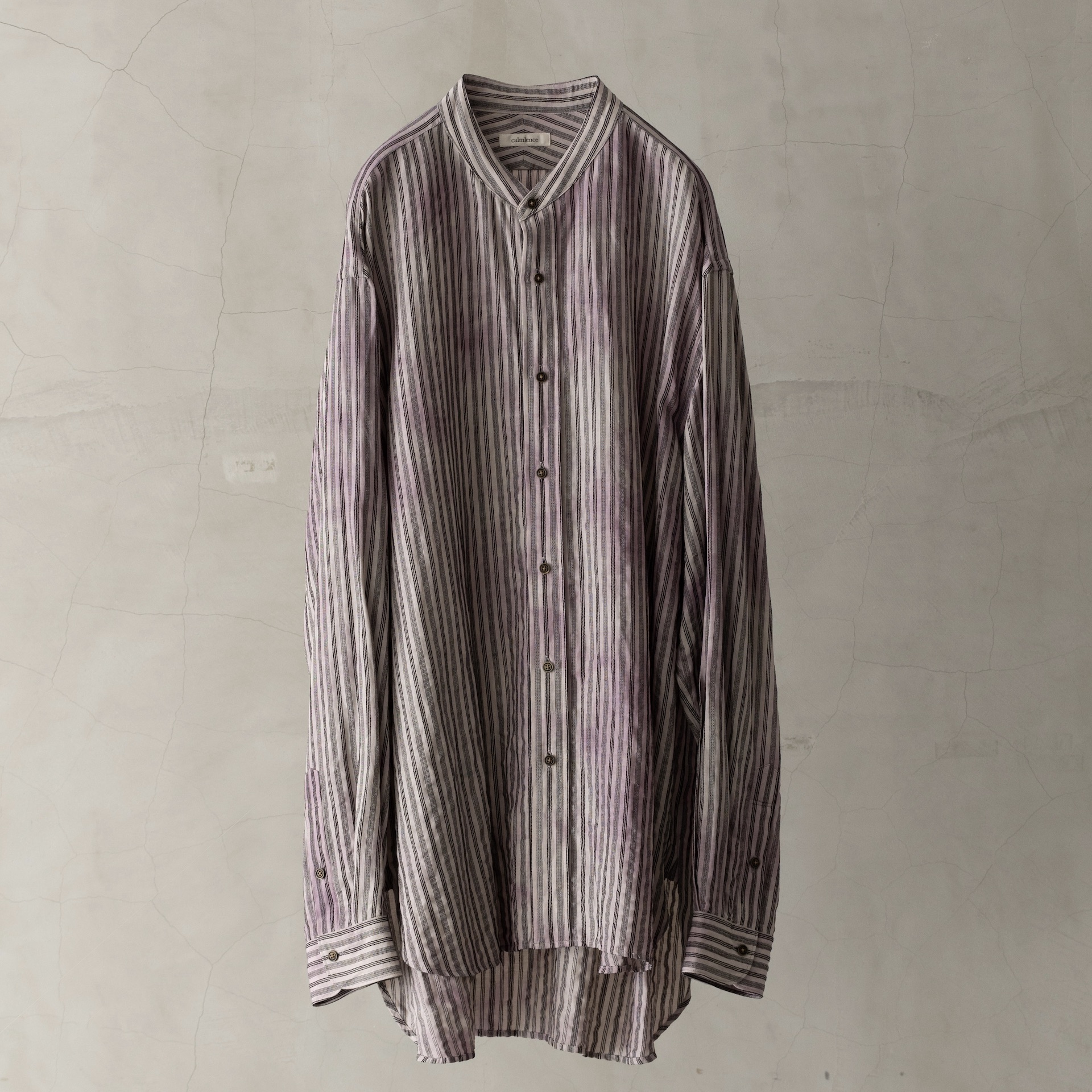
ピンクストライプ。


グレーストライプ。
それぞれが、最終的に手染めによるムラ染めが施され、浮き上がるようなストライプの上に、更なるテクスチャーが加えられているシャツ。
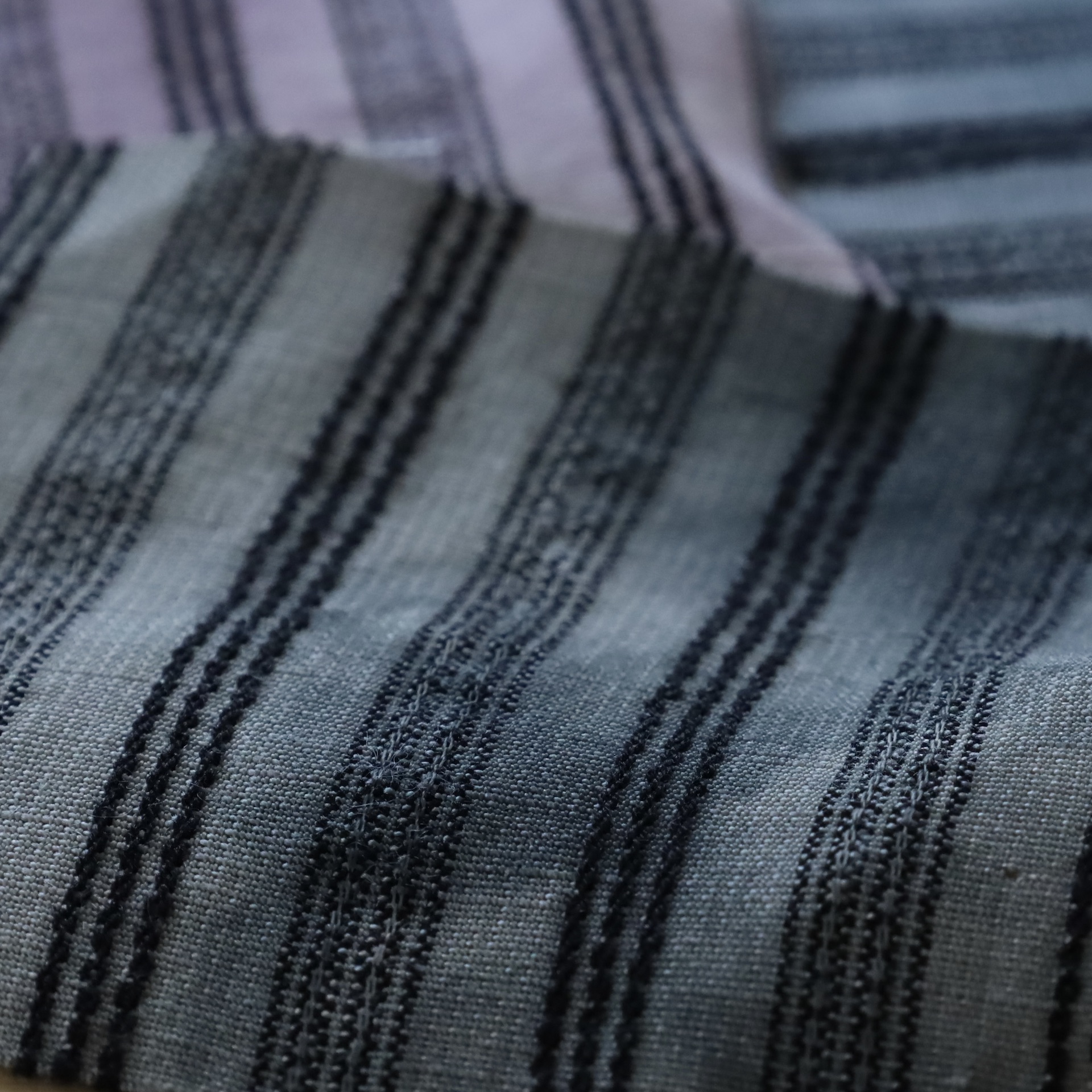
生地の構成は、
経糸には、75dのフィラメント(長い繊維の状態)レーヨンがベース。
黒いストライプの箇所は、先ほどのRANDOM BORDER生地の経糸と同じ、80番手双糸のコットン糸。
細いレーヨンに対して、倍近く太い40番手相当のコットンをストライプとして配置することで、柄を浮き立たせるようにしているもの。
対して、緯糸には、モダールとリネンをそれぞれ一列ずつ交互に打ち込んでいくというもの。
緯糸のモダールは、レーヨンの一種で、表記上は”レーヨン”となりますが、フィラメント繊維を短く切って紡績した”スパン糸”。
対して、経糸のレーヨンは、上記の通りフィラメント。
また、緯糸に自然な素材のフシがあるリネンが入ることも大きな特徴で、レーヨンが入る生地は、落ち感による生地のドレープ性が出るものですが、この生地は、緯糸にリネンが入るため横方向にハリが生まれ、落ち感を打ち消すような特徴的な生地のタッチとなります。
ツルッとした清涼感と、粗野な素材感。
あえて、硬い糸と柔らかい糸を交織させることで、デザイナー自身が好きな、相反する素材感が同居する質感を狙ったもの。

カラーバリエーションは、先に紹介した通り3色となりますが、染色前は、経糸のストライプの黒いコットン以外は、全て白い糸。
白と黒の”先染め”生地を織り上げ、その後に、ソーピングというムラなく染めるための洗い処理をし、仕上げ、その後に、綺麗に染色をする。
染色後、更に、ソーピングを施して余分な染料を取り除いた後、今度は手染めの染工場で、ベースよりも更に濃い色でムラ染めを行なうというたくさんの工程を要するもの。
生地を織り上げた後に、上記のように二度の染色。
そして、それだけではなく、それぞれの染色前後に必要な洗い加工など、手を加える回数が増える度に、経糸と緯糸を異素材、異番手で織り上げたことによる”収縮差”が生まれ、みるみる内に生地表面がボコボコと凹凸が生まれるそうです。
このことは、生地を企画する段階から逆算されている設計である。
ただ、そのようにストライプ部分が浮き上がってくることは意図しているものであるが、それをそのまま縫うことがないのがcalmlence。
ここから僕は、”更なる熊谷さんのテクニック”を知りました。
縫い上がった後、着用した後でも、設計外の歪みや変形が起こらないように、縫製に入る前段階で、それぞれの生地に応じた”最適な調整”を必ず行なうそうです。
“calmlenceの洋服が、calmlenceであるため”に必要とも言える工程であり、その”整える工程”は、非常に精緻に細かく狙い定められたもの。
規格通りに正確に縫い上げるために、生地が”どのような状態”で縫われることが最適であるかを考え、工程数が増えながらも、一つ一つ確実に必要であると考えられる工程を経ていくそうです。
その一つとして、どのようなブランド、メーカーのものに限らず、原反には生地端に、針穴が開いているのが見られる。
これは、仕上げ場にテンターという生地の端を針で刺して、引っ張って整え、巻き取る機械がある。
生地端に針穴が開いているのはそのためで、テンターで針に刺して生地を引っ張った跡。
僕自身は、原反で生地端に穴が開いていないものを見たことがないため、この工程は、多分ほとんど全部の生地で行われる当たり前の工程です。
しかし、calmlenceでは、そのテンターの使い方さえも、目指す完成形と、その生地の風合いに応じた選択をするそうで、中には針をかけずに、生地を巻き取ってもらうとかもあるそう。
通常通り、針で刺して引っ張ってしまうと、calmlenceで意図した生地の風合いではなくなってしまうこともあるそうです。
かといって、例えば、反対に生地洗いしたものを全く引っ張らずに手で巻くと、凹凸が出過ぎてしまって、縫うのが難しくなることもあるそうです。
洋服生産の現場で当たり前とされることでさえも、通例通りには行なわず、常に最善と考えることを実行し、工夫をすることを大事にされている。
これは裏地であっても同様で、ジャケットの身頃の裏地、袖のキュプラの裏地でさえも、生地洗いを施し、テンターにかけずナチュラルに巻き取る。
よく”縫った後に製品で洗う”。というような、製品加工を施される洋服は、その”崩したムード”を最優先に考えられ、多少大味な部分がある場合があります。
しかし、calmlenceでは、デザイナー自身が製品洗いを行なうのですが、それには、自らが最後に手を加えたいという精神と、一つ一つつくり込んだ生地を、着古したような柔らかく、馴染みのある素材感で纏って欲しい。
という考えのもとで行われています。
つまり、calmlenceの洋服は、製品洗いは行いますが、例えばそれによって起こり得る、表地と裏地の生地の縮率の差による歪みや、引き釣りは、ブランドの目指すところではない。
染色や、縫製など各段階で、目指す質感や色合いを実現するために加工は行いますが、手を入れれば入れるだけ、それに比例するように、意図していない生地の変化も起こる。
目指す風合いに一歩ずつ近付きながら、ブランドとしての基準を満たすために、完成までにどの工程を行なう必要があるのかと、順序を組み立てながら、常に先を考えながら洋服づくりを行なっているそうです。
だから、洗ったものを引っ張り、縫って、また洗う。というような非常に手のかかることさえも常に行なう。
何重にも積み重ねられる、それぞれの工程の全てが、calmlenceのクオリティを形づくるために必要なプロセスである。
今回のDOBBY STRIPEの生地の場合には、製織、ソーピング、仕上げ、染色、ソーピング、、、などいろんな工場を行ったり来たりしているそう。
それくらい、その工程を行わなければ成り立たない生地である。
calmlenceは、製品が完成後に、デザイナー自らが製品洗いを行うため、”縫い上げる前の生地の調整”というのは、洋服が完成してしまえば誰にも気付かれることがありません。
しかし、僕自身、以前から”なぜ製品洗いを行なっているのにも関わらず、これだけ洋服の隅々が整っているのか”と疑問に思っていました。
それには、記載したような理由があったことに気付かされました。
熊谷さん自身は、これまで長年のものづくりをやっていく中で、我流で導いてきた方法です。と言われていましたが、その言葉は本当に尊敬できることだと感じます。
また、そのcalmlenceのものづくりに関わる職人の方々も同様です。
縫製工場には、生地の端が折れ曲がった裏地が到着することもあるし、いわゆるフツーのものをつくる人たちではない。
通常ではない洋服づくりの工程を経て生産されるものであるため、calmlenceの洋服づくりには、一緒に面白がってくれる職人たちじゃないとやっていけないし、実際にそういう方々と一緒にやっていると言われていました。
一朝一夕にはできないものづくりであり、長年の経験と場数、関係性とのものづくり。
calmlenceの洋服を深く知ると、そのことが強く感じられます。
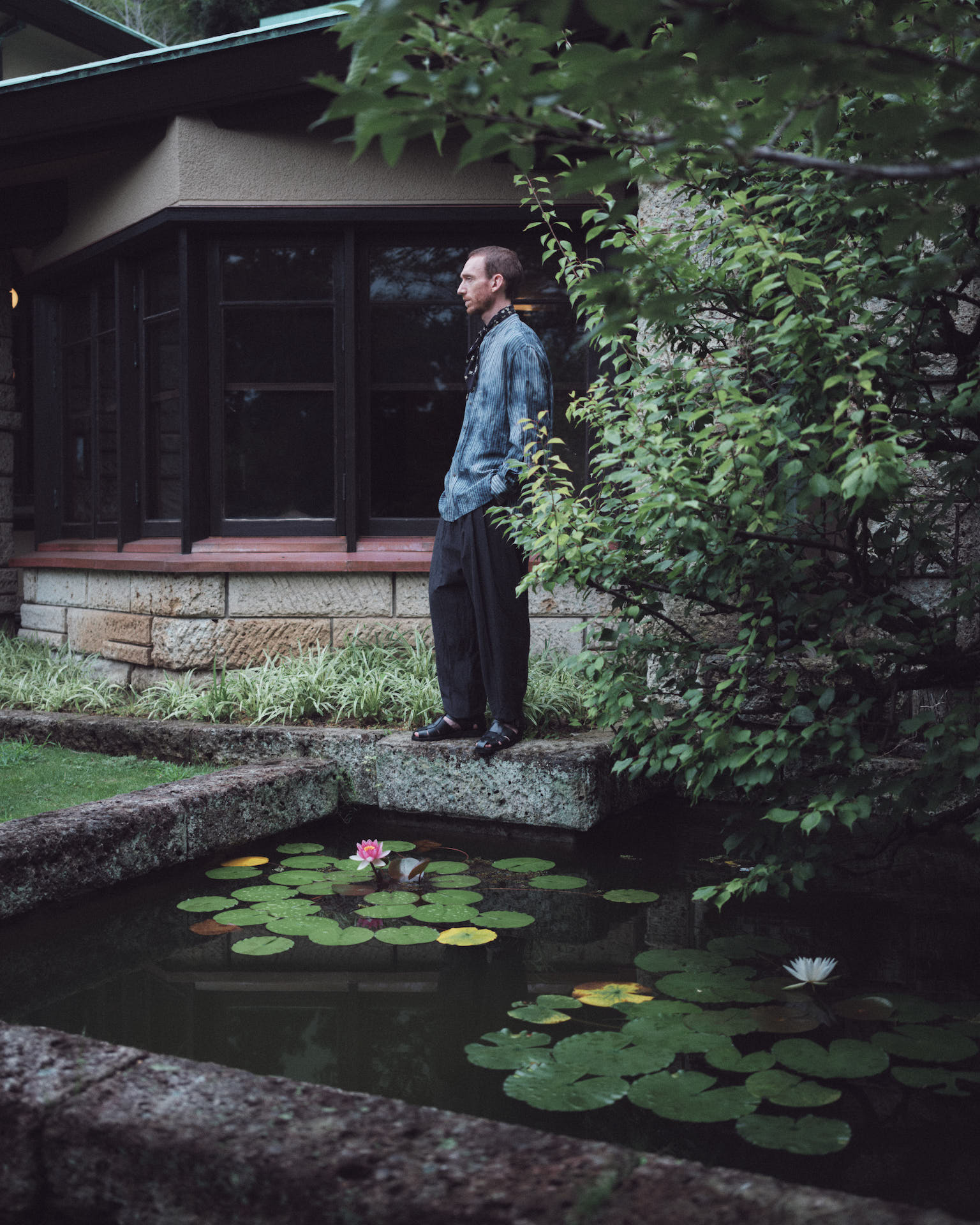

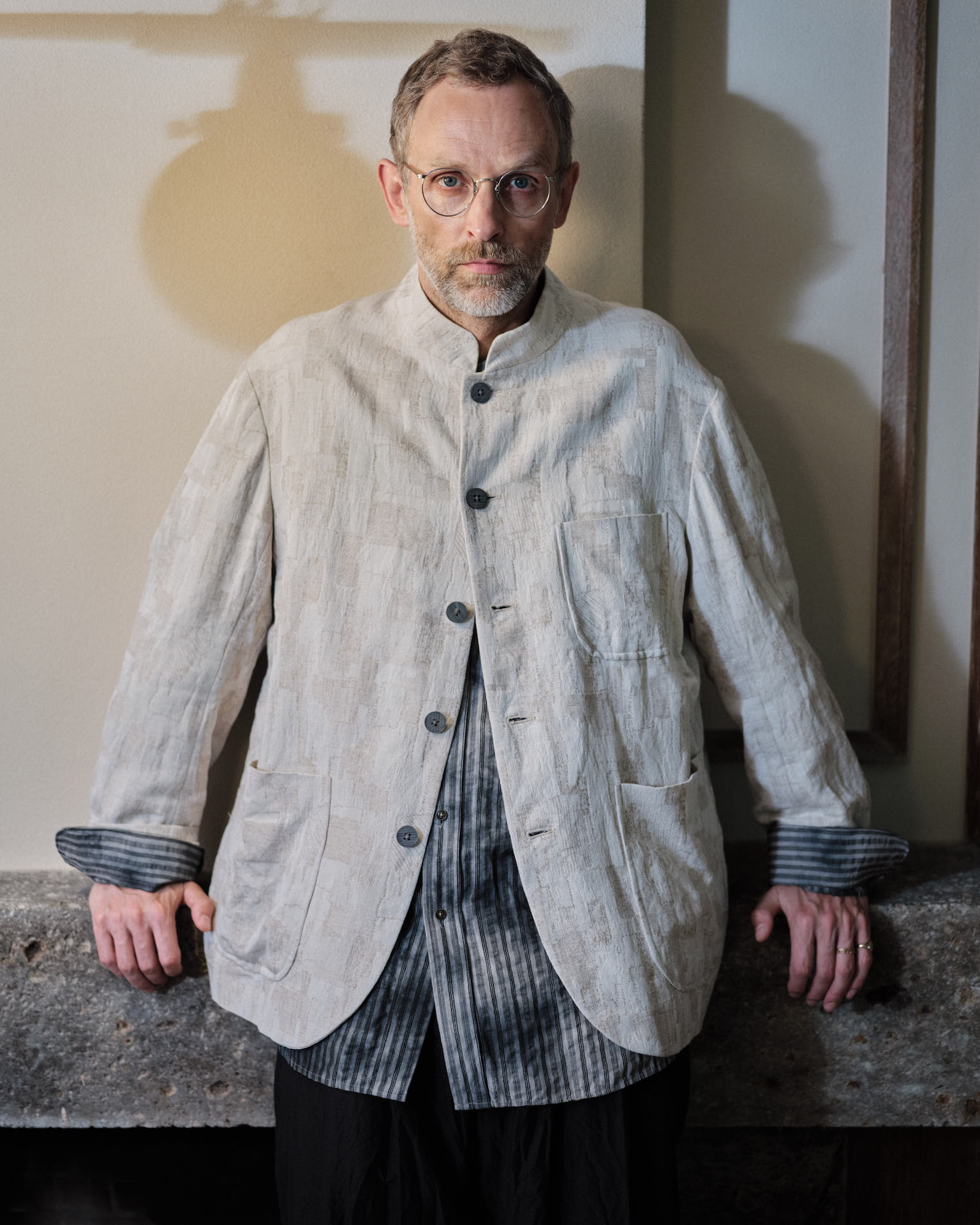
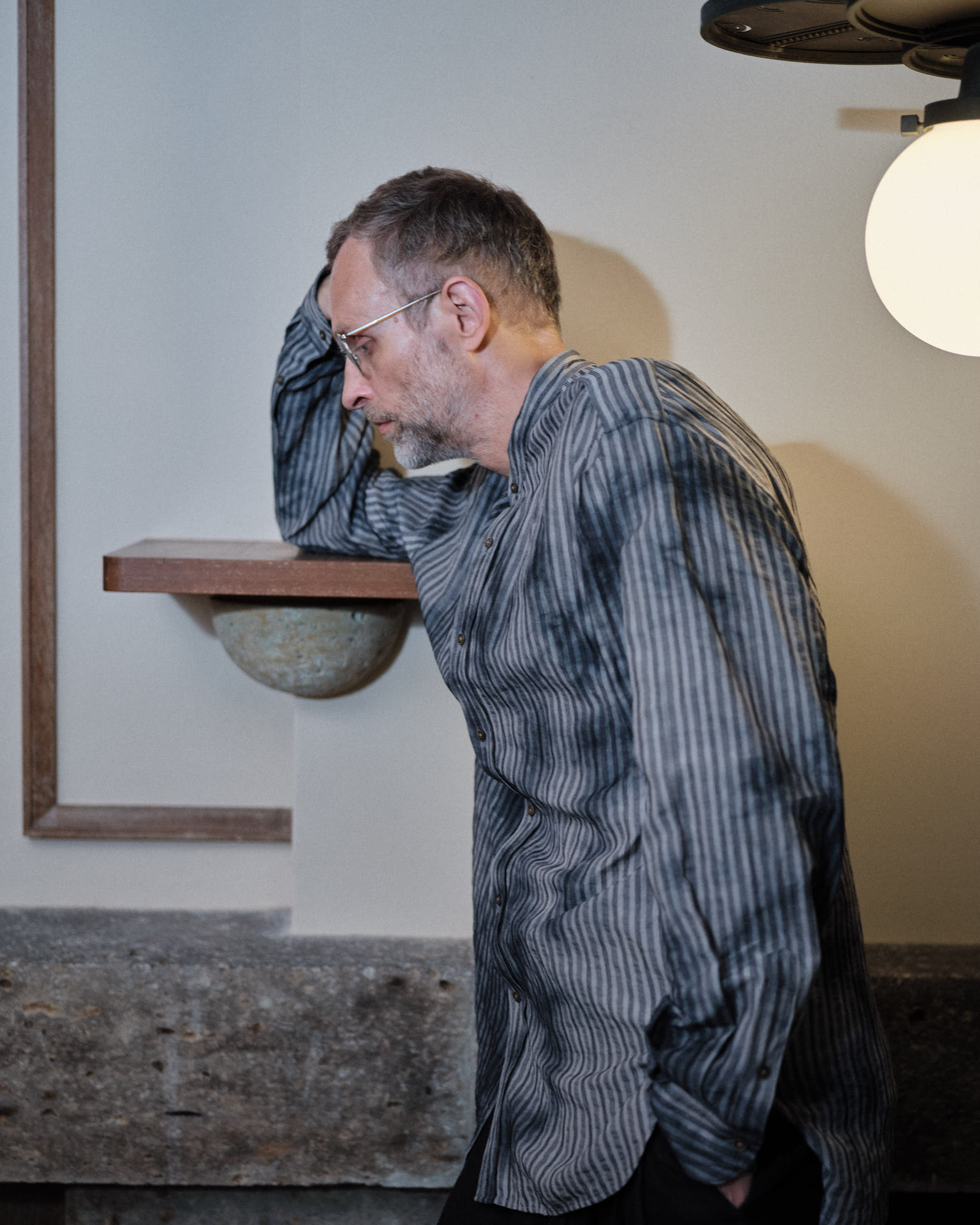
DOBBY STRIPEの生地を使ったBAND COLLAR SHIRTのルックの数々。
一着一着の洋服を生産するプロセスだけでなく、やはりこのようなルックイメージまで手を行き届かせること、尋常じゃないことだと思います。
今回紹介したcalmlenceのコレクションは、既に完売している店舗さんもあると思いますが、まだ見ることができるチャンスがあれば、ご覧頂けましたら幸いに思います。
LE BERGER / Herd Limited.
shop talk & communications by Akihiko Fukuda
__________
The English translation is as follows:
The other day, I gave a brief introduction to calmlence as a whole.
(You can read that article here:)
“Kumagai’s Projection” – calmlence
This time, I’d like to talk about something essential to understanding the craftsmanship behind calmlence—the “fabric” itself.
From the currently available Collection 004, I’ve picked two fabrics to highlight:
- Li/Co/W/He RANDOM BORDER
- Ry/Li/Mo/Co DOBBY STRIPE & DYED
These are the two I’ll focus on.
As I revisited the fabric structures, I was reminded how deeply infused they are with the essence of calmlence.
Let’s begin with the “RANDOM BORDER” fabric.
A blend of multiple tones, with an irregular and incredibly intricate appearance of the threads—
The fabric’s surface is uneven and richly textured, creating a depth that is truly rare.
At a glance, it’s nearly impossible to decipher how the structure was formed. It’s a fabric that designer Kumagai confidently states, “You won’t find anything like this elsewhere.”
He also shared some particularly thought-provoking words:
“I don’t think this is a fabric you can create just by ‘thinking with your head.’
It’s something that only came to life through relentless physical movement.”
Let me introduce it to you in more detail.
This fabric consists of four different types of yarn.
The warp is a black 80-count two-ply cotton yarn. This warp thread rarely appears on the fabric’s surface.
There are three types of weft yarns:
The first is quite complex. Wool and hemp fibers are blended through spinning into a single yarn. Only the wool is dyed black, leaving the hemp white due to the difference in fiber properties. This results in a thick 24-count single yarn. Then, a black-dyed linen yarn of fine 60-count is twisted with it, creating a unique thread in which black wool, white hemp, and black linen combine to create a flickering, kasuri-like expression. This yarn is, in my opinion, emblematic of calmlence.
The second is a black cotton 40-count single yarn. While the warp is a two-ply 80-count thread, this weft is arranged to match its thickness and enhance the characteristics of the other weft yarns. Although the warp uses two-ply for added strength, the weft uses a single yarn of similar thickness.
The third is a 43-count two-ply linen yarn dyed brown. This is a thick brown thread that stands out in the RANDOM BORDER fabric.
These unique yarns are woven on a jacquard loom in Bishu, a region known for its wool fabrics.
Jacquard looms are said to be capable of “doing anything,” but Mr. Kumagai says, “Precisely because they can do anything, it is your sense and intuition that create distinction.”
This fabric is so carefully designed that Mr. Kumagai himself has said, “This is not a fabric that could be created by thinking alone—it required moving my body.”
The weaving partner in Bishu is known for their cutting-edge technology. In the past, Mr. Kumagai has worked with makers using vintage looms for traditional suiting fabrics, but now he collaborates with a mill using the latest jacquard looms to develop calmlence’s original textiles.
Interestingly, while Bishu typically uses wool for warps, the mill in this case usually weaves non-garment materials like car seats with ultra-fine polyester in both warp and weft. For calmlence, they ran countless experiments at the end of their production runs, using various yarns that Mr. Kumagai had prepared.
This fabric, especially elaborate within calmlence’s lineup, is described by Mr. Kumagai as:
“A fabric that could not be born from just moving your head—it required physical effort.”
But these trials weren’t random. Mr. Kumagai had already envisioned the “landing point” through his experience. With that destination in mind, they started by replacing polyester with linen and other fibers, trying different structures until they got it right.
Listening to him speak, I got the sense that about 70% of the outcome was foreseen, while the remaining 30% was entrusted to technical serendipity.
This ability to imagine a goal, based on years of experience, allows him to confidently explore new territory. And unless that remaining 30% is successful, the fabric never makes it into the collection.
The balance between a clearly envisioned endpoint and trust in the process and its techniques—that’s calmlence.
What looks like an old, heritage-style textile is in fact produced with state-of-the-art looms and refined skills.
And as I’ll discuss another time, this process made me realize just how deeply calmlence is rooted in a “dual-axis” approach to creation.
Mr. Kumagai has said he is always conscious of this, and each calmlence collection is developed around two clear axes. This ability to work at such a complex, high level across those two axes is what sets calmlence apart.
To put it bluntly—when I heard all this, my honest thoughts were:
“This is seriously incredible.”
And also—
“I wish I had known this back when I was a buyer.”
The weft yarns, both in their composition and arrangement, exude a remarkable complexity.
Given that this collection is for the spring-summer season, there are inevitably certain limitations in the production process. The question then becomes—how far can one push within those constraints?
By incorporating threads that create a kasuri-like expression, as well as various yarns previously developed and used by calmlence, this fabric gains exceptional depth and richness.
It wouldn’t be an overstatement to say that the fabric known as “RANDOM BORDER” is a concentrated embodiment of all the textile work the brand has done up to now.
<Ry/Li/Mo/Co DOBBY STRIPE>
This fabric, named “Dobby Stripe,” is composed of a blend of 46% rayon (including one type listed as modal), 32% linen, and 22% cotton.
Like the previously mentioned fabric, it is woven using a jacquard loom.
Typically, stripes with a blocky and moderately detailed woven pattern like this are created on a dobby loom—hence the term “dobby stripe.” At calmlence, this naming is used to help convey the visual impression of the fabric. However, in reality, this specific woven pattern cannot be achieved without the finer and more intricate capabilities of a jacquard loom.
This fabric is not only a jacquard-woven stripe, but is also the result of numerous essential processes—combining various mixed fibers, complex dyeing techniques, and finishing treatments.
The collection features this fabric in three color variations.
The warp yarn is primarily composed of 75d filament rayon (a continuous, long fiber).
The black stripe sections use the same 80-count two-ply cotton yarn found in the previously mentioned “RANDOM BORDER” fabric.
To make the stripe pattern more pronounced, this thicker cotton (equivalent to about 40-count) is placed alongside the much finer rayon, creating a visible contrast in texture.
In contrast, the weft yarn alternates row by row between modal and linen.
The modal weft yarn is a type of rayon—technically listed as “rayon”—but it’s a spun yarn made from short-cut filament fibers.
The rayon in the warp, on the other hand, remains in its original filament state as mentioned above.
A key feature of this fabric is the inclusion of linen with natural slubs in the weft.
While rayon typically gives a fabric a fluid drape, the addition of linen in the weft introduces horizontal firmness, which counteracts the draping quality, resulting in a fabric with a unique texture.
This creates a balance between a sleek, refreshing touch and a rustic, organic character.
By deliberately interweaving stiff and soft yarns, the designer aimed to achieve a tactile sensation where opposing material qualities coexist—something that reflects his own personal aesthetic.
Color Variations and Fabric Preparation in calmlence’s DOBBY STRIPE Fabric
As mentioned earlier, this fabric comes in three color variations. However, before dyeing, all the threads—except for the black cotton used in the warp for the stripes—are white.
The fabric is first woven using these black and white threads as a “yarn-dyed” textile. It then undergoes a scouring process (a special wash to remove unevenness in dye absorption), followed by finishing and primary dyeing.
After the initial dyeing, the fabric is scoured again to remove any excess dye, and then undergoes hand-dyeing using a deeper tone than the base, creating a nuanced and layered coloration. This results in a lengthy and complex production process.
The fabric is dyed twice, as described, but that’s not all. With each added step—washing before and after dyeing, and more—the difference in shrinkage rates between the warp and weft threads, which are of different materials and thicknesses, causes the surface of the fabric to develop a distinct, uneven texture.
This textured surface is not accidental. It is intentionally designed from the planning stage.
And yet, despite these raised stripe sections being intentional, calmlence never sews the garments as-is. Here is where I learned of Kumagai-san’s further technical depth.
To prevent distortion or unwanted deformation after sewing or wearing, calmlence always adjusts the fabric beforehand in a way optimal for each textile. This “preparation process” is essential for ensuring that calmlence garments truly embody the calmlence standard. It’s a highly meticulous and precise operation.
To achieve accurate tailoring according to design specifications, they calculate the best condition for the fabric before sewing begins. This often adds more steps, but each one is deemed necessary.
One example: no matter the brand or maker, raw fabric rolls (greige) usually have small holes at the selvedges. This is due to the tentering machine, which stretches and sets the fabric by pinning the edges. These holes are evidence of this common process.
However, calmlence even approaches this standard process differently. Depending on the final texture they aim to achieve, they may request the fabric to be rolled without pinning it. Using pins could distort the texture they have in mind, while not stretching it at all could cause the fabric to become too uneven for sewing.
In other words, even in areas considered standard in garment production, calmlence always pursues what they believe is optimal, without blindly following convention.
The same applies to lining fabrics. Even the jacket body lining and cupro sleeve linings are washed and rolled naturally, without tentering.
In the world of fashion, garments that undergo garment-washing after construction are often intended to create a “worn-in” mood. While this can result in charming looseness, sometimes it compromises precision.
At calmlence, however, the designer performs the garment-washing himself—not for aesthetic roughness, but because he wants to add the final touch personally. He wants wearers to enjoy the soft, familiar feel of well-worn material crafted with care.
So yes, calmlence garments are garment-washed, but the resulting shrinkage or misalignment between the outer and lining fabrics is not part of the brand’s intent.
Throughout the stages of dyeing and sewing, calmlence uses precise treatments to achieve the target color and texture. But the more you process fabric, the more unintended changes occur.
Thus, calmlence builds each step toward the final texture while always keeping the goal in mind, crafting each garment with forward-thinking care.
This is why they do time-consuming work like stretching a fabric after washing, sewing it, and washing it again.
Every layered step in this process is essential to calmlence’s level of quality.
For the DOBBY STRIPE fabric, the cloth travels back and forth between various factories for weaving, scouring, finishing, dyeing, scouring again—and more.
It’s a fabric that can’t be completed without all those steps.
Because calmlence performs garment-washing after a product is finished, adjustments to the fabric before sewing are something the customer will never notice once the piece is done.
But I always wondered: how could their garments be so neatly structured, even though they’re garment-washed?
Now I understand—because of everything mentioned above.
Kumagai-san describes his approach as something he developed through years of experience—his own “method,” if you will. And I deeply respect that.
The artisans who work with calmlence are the same. Their workshops often receive fabric with irregular edges. These are not people making “standard” clothing.
Because their production process is unconventional, calmlence needs craftspeople who can find joy in this kind of work—and indeed, they do collaborate with such individuals.
It’s not a method that can be achieved overnight. It’s built on years of experience, repetition, and strong working relationships.
When you truly get to know calmlence garments, you can feel this in every detail.
A series of looks featuring the BAND COLLAR SHIRT made from the DOBBY STRIPE fabric.
It’s truly remarkable—not only the meticulous process behind the production of each individual garment, but also the attention given to the visual presentation of the collection. The care taken in crafting these lookbook images is nothing short of extraordinary.
Some stores may have already sold out of the calmlence pieces introduced here, but if there’s still a chance for you to see them in person, I sincerely hope you’ll take the opportunity.
